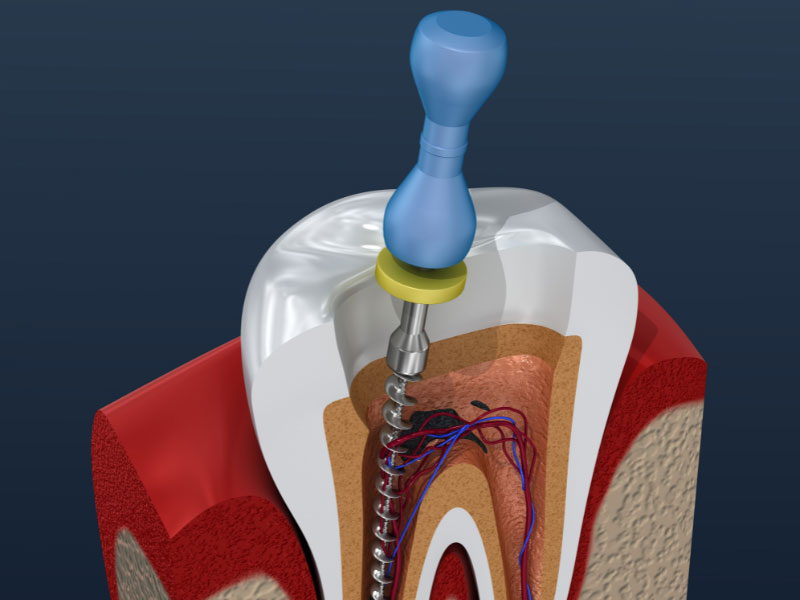Root Canals at Your Las Vegas Dentist

We suspect some of you are here right now because you’re suspicious you may need a root canal due to that extreme tooth ache that just won’t go away, and now you’re doing some panic research before deciding if you really have to make that dreaded dentist appointment. (We say just make the appointment. It’s better to be safe than sorry, and your dentist is the only one who can positively identify what’s wrong and how to treat it). But with that being said, sometimes it’s a bit easier going into an anxiety provoking situation when you at least know a little about it, so let’s take a dive into root canals and go from there.
Root Canals Explained
Root canals are a fairly common term that most people have heard of, but that doesn’t necessarily mean they know what it means…(don’t worry, we won’t tell AND we’ll give you the low down). Let’s start with the fancy definition: A root canal, also known as endodontic treatment, is designed to eliminate bacteria from the infected root canal, prevent reinfection of the tooth and save the natural tooth. When one undergoes a root canal, the inflamed or infected pulp is removed and the inside of the tooth is carefully cleaned and disinfected, then filled and sealed. (American Association of Endodontists, 2023). Essentially, root canal treatment is needed when a cavity goes untreated for too long and ends up reaching the pulp of the tooth, which is a mass of connective tissue that resides within the center of the tooth (National Institutes of Health, 2023). Though cavities are the most common reason we see patient’s needing root canals, there are a multitude of reasons you may need one. Really any way the pulp may become inflamed or infected such as repeated dental procedures to one specific tooth, or even a crack or chip in a tooth could cause damage to the pulp.
Once the pulp of your tooth is infected, you have two options; have root canal treatment, or extract your tooth. If you have a choice, it’s much better to be able to have a root canal done and save your natural tooth. At Willow Springs Dental, when we perform root canals, our main goal is to save that tooth. We do that by cleaning out all of the tooth pulp that has been infected and then proceed to disinfect the canals of the tooth. Once the infection is completely removed, we fill in the canals of the tooth so as to not allow any further infection to occur.
Symptoms That Suggest You May Need a Root Canal
Now let us remind you, just because you have one of these symptoms, it does not mean you are doomed, or that you are even guaranteed to need root canal therapy, but the American Association of Endodontists suggests that if you are experiencing any of the symptoms below, you may need a root canal and should make an appointment with your dentist as soon as you can. Some symptoms include:
- You experience severe pain while chewing and / or biting
- Small ‘pimples’ form on your gums
- You have a cracked or chipped tooth
- Extreme sensitivity to hot or cold food and drinks that lingers even after the sensation has been removed
- Swollen, sore and tender gums
- Deep decay or darkening of the gums
What to Expect When Receiving Root Canal Treatment
We know, the actual procedure is typically the part patients are most afraid of, so again, let’s educate you a bit on what the procedure entails. Sometimes the unknown is the scariest part! Root canals are usually performed in one, occasionally two visits. Though each patient’s situation is different, your treatment will follow along the lines of these steps:
- First, we examine the infected tooth and take x-rays. We then administer local anesthetic to numb the tooth before placing what we call a ‘dental dam’, a small protective sheet, over the area in order to isolate the tooth and keep it clean and dry during the procedure.
- We create an opening in the crown of the tooth so that we can clean the pulp from the pulp chamber and root canals, and to properly shape the space for filling. We promise this sounds more intimidating than it is, the instruments we use for this step are very small and we do our best to keep you comfortable throughout the procedure.
- After the space has been prepared, we fill the root canals of the tooth with a rubber like material called gutta percha. To be sure the root canals are completely sealed, we use an adhesive cement along with the gutta percha.
- The final step is to have some form of restoration, usually a crown, placed on the tooth for protection and to restore the tooth to its full functional ability. (American Association of Endodontist, 2023)
The Benefits of Root Canal Treatment
We’re hoping the play by play of a root canal treatment didn’t scare you away, but in case it did spike your nerves, let’s remind ourselves of the great benefits of undergoing root canal treatment!
- It stops the spread of the infection to surrounding teeth.
- It keeps your smile looking good! Saving your natural tooth means having the look of your natural smile!
- It saves your natural tooth and prevents the additional care an extracted tooth would require.
- It improves your oral health as well as your overall physical health which can often be affected by an infection in the pulp of your teeth.
Root Canal Treatment at Your Summerlin Dentist
We don’t mean to brag, but at Willow Springs Dental, we pride ourselves on being the best dentist in the Las Vegas area. We offer services for any and all of your dental health concerns, from teeth whitening to full mouth reconstruction, and our team is filled with experts who are passionate about what they do, and who always strive to provide the most comfortable experience for our patients. Like we said, we know a visit to the dentist isn’t anyone’s favorite pastime, but you owe it to yourself to be in good health and feel even better. Whatever your concerns are, schedule an appointment with us today and we’ll get you back on track and give you the smile you deserve!



